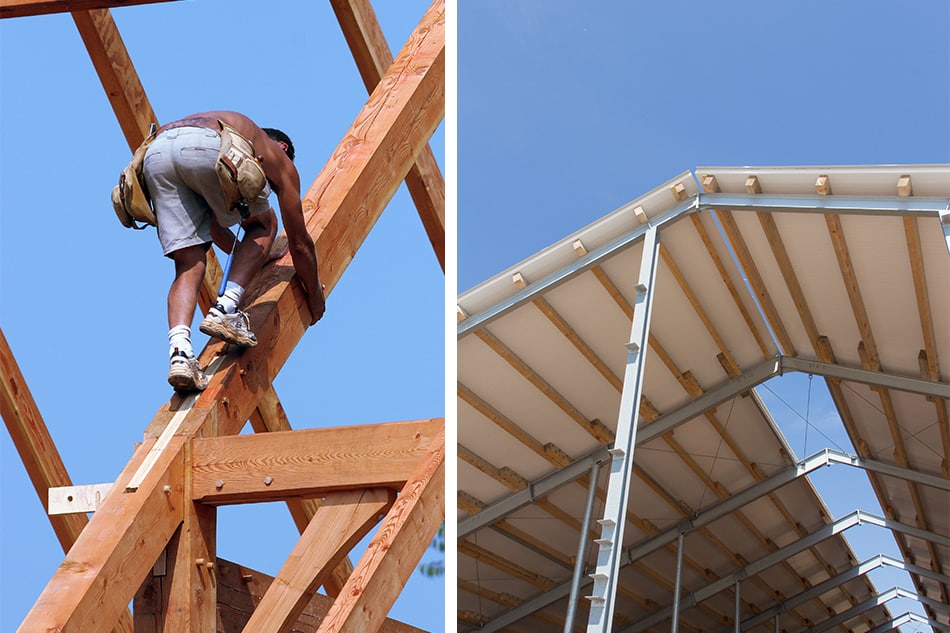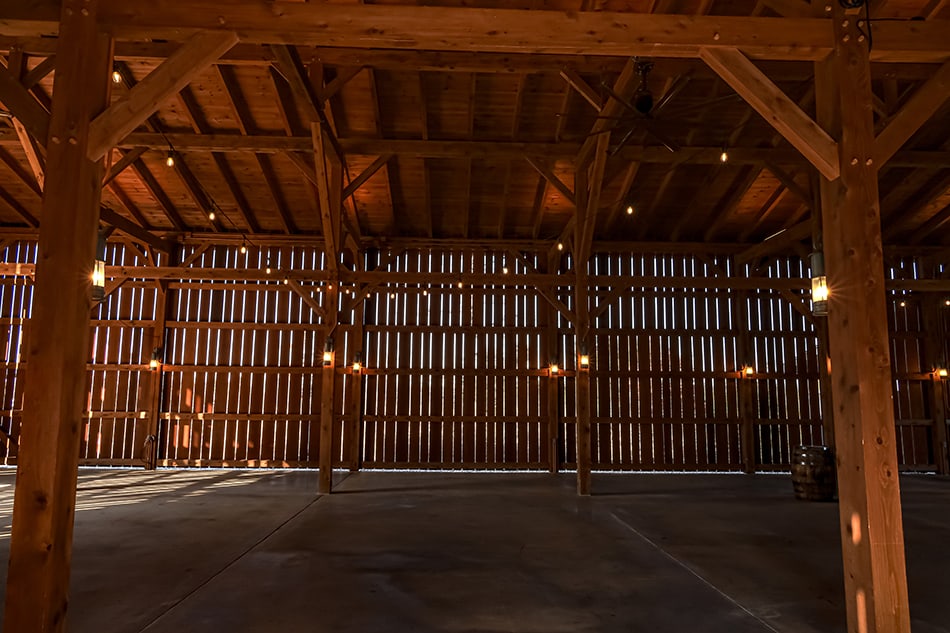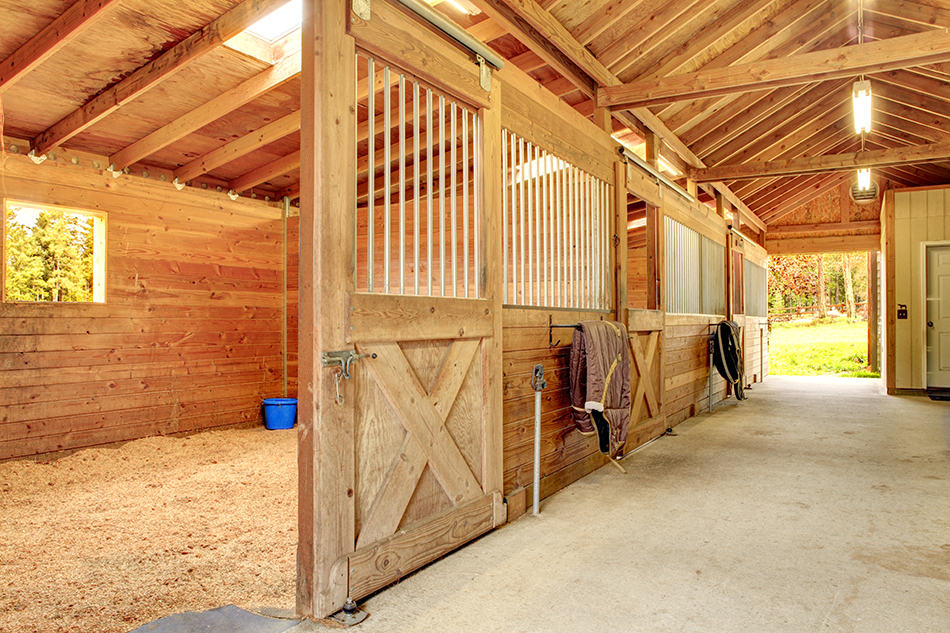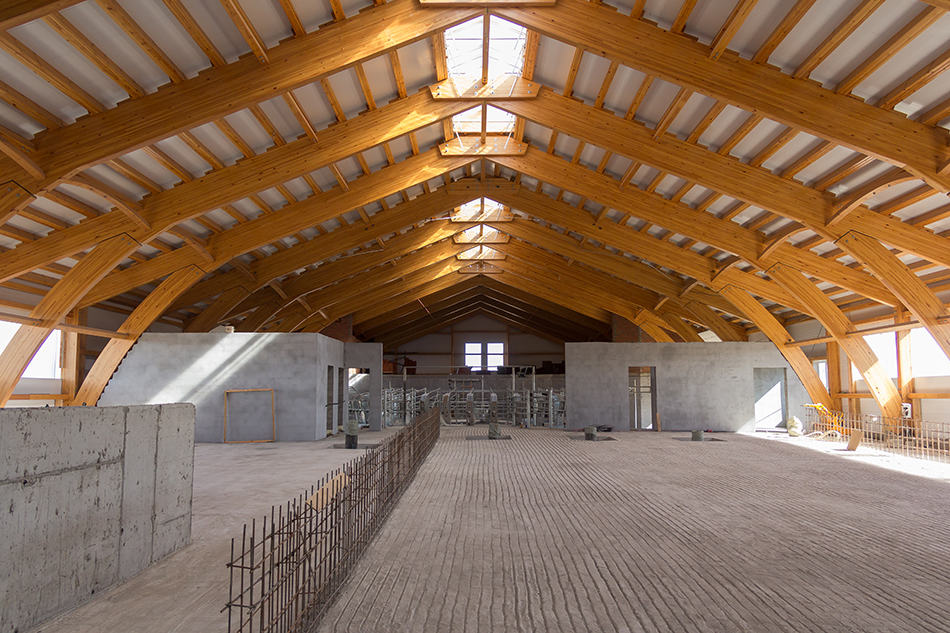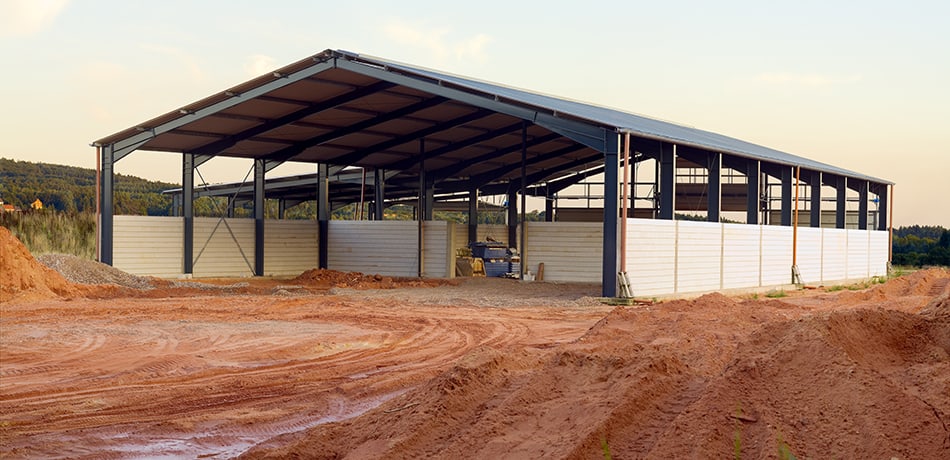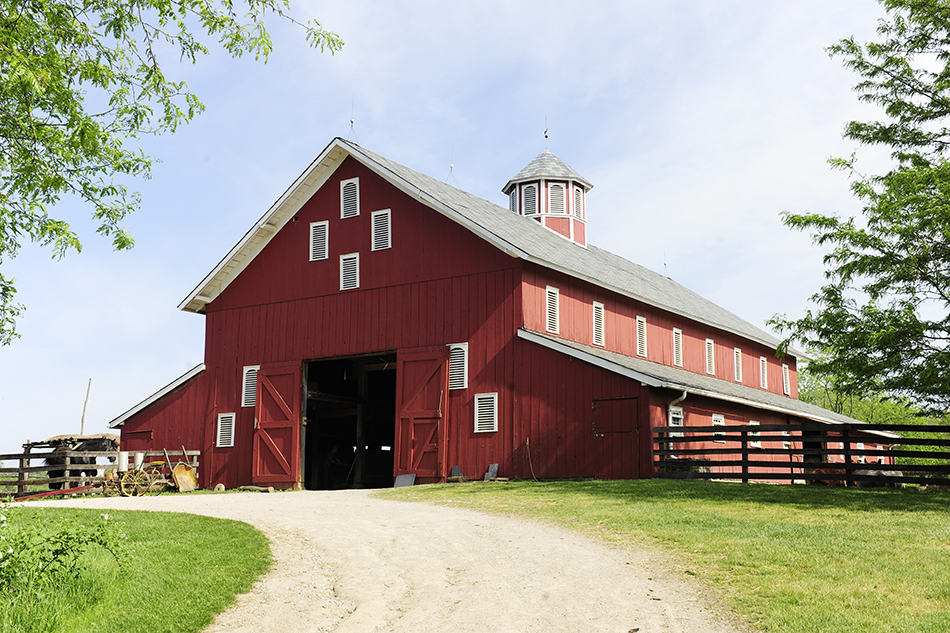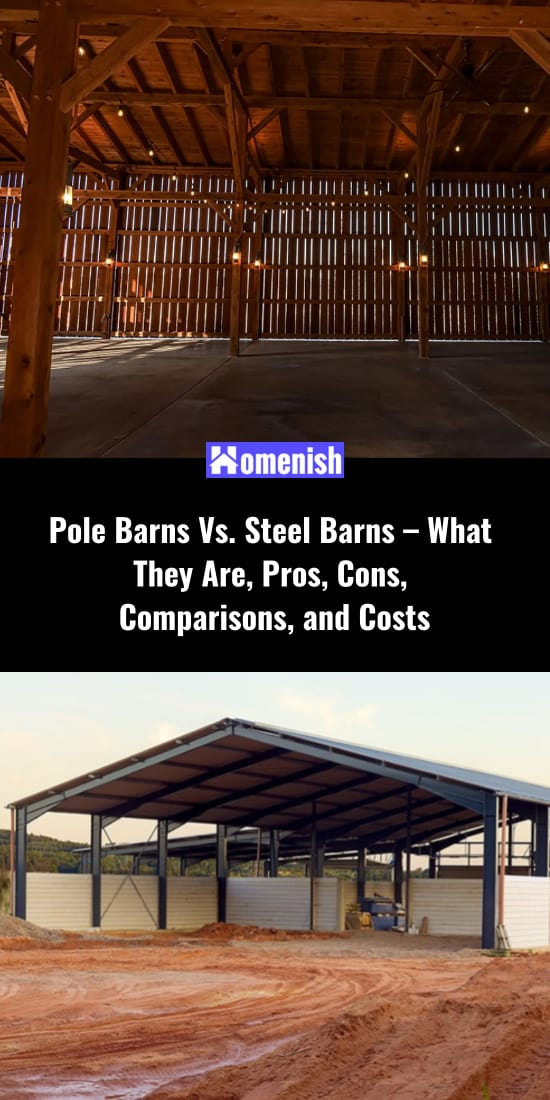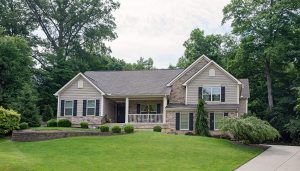You need a barn but aren’t sure where to start? Can difficult can it be to build a barn? But where do you get plans? And what’s the best material to use? What’s a pole barn anyway?
Those are all great questions, and we’ll do our best to answer them to give you a better idea of how to proceed.
First, we’ll take a look at pole barns vs. steel barns, then go into more detail about pole barn kits and whether it’s better to purchase pole barn kits or buy your own materials.
What Is a Pole Barn?
The definition of a pole barn is a simple barn structure characterized by the inclusion of wood poles as beams to hold up the roof and reinforce the exterior walls. It may include interior walls for stalls, separate storage areas, or even office space, but it doesn’t need to. It could be a wide-open area for storing hay, farm equipment, or other goods.
A pole barn could be fully finished and insulated or left in any state of completion, depending on your needs. You might hear this type of building called post-frame construction. Indeed, pole barn and steel-frame barn are great structures for a barndominium house.
Interestingly, the pole barn-building technique became popular not that long ago. It was in the 1930s when Americans were looking to save money any way they could. Some smart farmers saw that they could reuse old street light poles to hold up their barns. From there, it was a simple step to grabbing tree trunks and logs to actually cutting poles for the purpose.
While the building technique may sound structurally weak, relying on interior beams to hold up the roof and the weight of the roof to bear down and keep walls in place, it’s actually quite stable. The danger is water damage and termites if you’re using wood beams.
In most cases, the exterior walls will fail first if you’re using wood. They simply rot from weather exposure. Still, this doesn’t weaken the integrity of the structure, and wood slats can be replaced with no problem. A wood beam will only fail if there’s a consistent roof leak or a beam is too close to an opening. To prevent these issues, install a long-lasting metal roof and ensure you have barn doors, not open doorways.
Because the building design is so simple, you can save on both materials and labor for the setup of the frame. You can usually DIY the finishing touches, such as insulating it or adding electricity. If you want something more than a dirt floor, be sure to add this as part of the initial building project, as it can be a pain to cut and install flooring after the beams and walls are in place. The exception to this would be pouring concrete, which you can do any time and would only add to the structural integrity of the building.
Types of Pole Barns
Because a pole barn is simply an architectural style, you can use the design for nearly anything. You could build a post-frame house if you wanted to go ultra-rustic with an open floor plan.
Here are the most common uses for post-frame buildings.
Garages, Utility Barns, and Shops
Do you have a business or hobby fixing up cars, boats, or other equipment? A pole barn would give you more room to work and plenty of clearance to pull in and out. If it’s a commercial establishment, you can put up walls to receive customers in the front and have your work area in the back. Add electricity and plumbing as needed.
Or maybe you’re looking to build an inexpensive storefront. Set up your aisles or tables of goods in the main barn area and leave room for a register or two at the front. Insulate it for comfort and to make it an inviting, year-round shop for customers to visit.
Of course, you can use it to store your own farm equipment on a working farm. Add electricity if you need to be able to work on your equipment in the barn.
Horse Barns and Arenas
Keep your livestock or horses in the pole building. You can also host live events in a pole building, with the entertainment happening in the center and seating all around. If you’re a savvy entrepreneur in the right location, you might be able to rent out your pole barn to other organizations, wedding parties, etc.
Industrial Building Space
Do you need to build a space for your small manufacturing shop? The open plan of a pole structure makes it ideal for laying out large machinery. You can even include catwalks to access your machinery for maintenance. Complete the building to any degree you need.
What Is a Steel Frame Barn?
The biggest competitor to the pole barn structure is the steel frame barn. Steel barns are more expensive in material costs, but they’ll last longer than pole structures and require less maintenance. Plus, they’re 40% less expensive to insure due to their lower fire risk.
You do normally want a fully concrete floor in a steel barn to keep it structurally secure. If you were to use it for farm animals, you could pour dirt on top of the concrete, just as they do for some events at nationwide arenas.
How to Decide between a Pole Barn and a Steel Barn
Let’s take a look at the advantages and disadvantages of each.
Pole Barn Benefits
- Cheaper to build
- Faster to construct
- Can be built DIY
- Provides a more rustic appeal
- Maybe left unfinished
- Customizable for user needs
Pole Barn Drawbacks
- Wood is susceptible to rot and fire
- Cannot add a basement
- Won’t last as long as steel structures
- Doesn’t keep the heat if not finished and insulated
The advantages of a wood pole barn are seen at the outset. They’re cheaper and faster to build. You can even do most of the work yourself.
But you are dealing with wood rather than metal, so it’s more susceptible to weathering, catching fire, and ultimately deteriorating. You wouldn’t want your animals or expensive equipment or goods in a pole barn if it catches fire or collapses. You’d need to keep a close eye on maintenance to prevent as many issues as possible.
Steel Barn Benefits
- Stronger frame
- Longer lasting with less maintenance
- No risk of fire or termite damage
- 40% cheaper to insure
Steel Barn Drawbacks
- More costly to build
- Requires specialists to build
- Susceptible to rust
- Might not be as visually appealing
In contrast to wood pole barns, a steel barn shows its value in the long run. There are types of steel that are less likely to rust, but this is still something you’ll want to watch for. If you do develop a rust spot, it can be more expensive to replace that piece than if you needed to do some maintenance on a leaky pole barn.
Both pole barns and streel frame barns are sound investments, provided you’re willing to perform the necessary maintenance. The decision between one or the other may come down to your available funding and the look you’re going for. A steel frame structure will look out of place on some properties, just as a pole barn may give an unprofessional impression of a business.
Pole Barn Kit vs. Purchasing Your Own Products
If you’ve decided to go with a pole barn, you have two options: build it yourself or hire a building company. And if you’re preparing to DIY your pole barn, you also have two alternatives: purchase a pole barn kit or select and purchase your own products.
Pole Barn Kit vs. Buying Your Own Pole Barn Building Materials
Just as building a pole barn is easier than building a steel frame structure, buying a kit is easier than gathering and sourcing your own materials. But there are other pros and cons to think about.
Do you want to do the job as quickly as possible? Or do you want to be able to customize the plans for the barn?
Can you find the products you need at a lower cost, or will some things be more difficult to get in your area? How about your level of construction ability? Are you comfortable taking measurements and making the cuts you need? Do you work better following instructions or visualizing the final product yourself?
Based on your answers to those questions, you probably have an idea of what you need already, but let’s go a little deeper into the pros and cons of purchasing a pole barn kit vs. buying the materials separately.
Benefits and Drawbacks of Purchasing a Pole Barn Kit
Pole barn kits are widely available online or through most large home improvement stores.
Here are a few of the positives to purchasing a pole barn kit:
- All the materials you need to be sourced for you
- Everything pre-cut and ready to install
- Various sizes and models available
But there are also some negatives to pole barn kits, such as:
- You pay more for the convenience
- You can’t make any changes easily
- The products you get may not be the best quality
Product quality is the most concerning element. You can find pole barn kits that match your size and layout requirements easily enough, but be careful about quality. Some are priced to sell, which means they’ve sourced cheaper materials, while the ones with better materials will cost more than if you bought comparable quality on your own.
Benefits and Drawbacks of Purchasing Pole Barn Building Materials Separately
Why take the extra time to select your own materials?
- You feel confident in the products you purchase
- You can make changes in the plan and substitute materials more easily
- It’s more economical; you can save big on a large project like this
Basically, when you shop for your own pole barn materials, you have complete control. You get to choose how many windows your pole barn will have, whether it will have an overhang, what type of doors, and more.
But here’s why you might not want to select your own materials:
- It takes a lot of time to research, inspect, and order your products
- Any mistakes in ordering can cause significant delays in construction time
- You may not have the experience to know what you need and how to find it
A lot of it comes down to experience and how much time you want to put in to sourcing your products. If you know what you’re doing, ordering materials will be no problem.
Where to Find Pole Barn Plans?
If you hire a builder, they can show you a variety of pole barn plans and explain their costs. You can also purchase pole barn plans to build yourself. Depending on your layout, you can find and order very simple to much more complex building plans. Of course, you can also search by size of building you want to build or scale a structure up or down according to your needs.
What Is the Cost of a Pole Barn?
Because a pole barn is so simple and fast to erect, the difference in cost between building it yourself and paying a contractor is less than it would be for a house, steel barn, or commercial building.
A quick look at pole barn kits shows price ranges from $8,000-14,000, depending on size. Again, you can buy the materials you need for a little less, possibly saving one or two thousand, depending on the quantity of materials needed. If you decide to hire a builder for your pole barn, the cost starts at $13,000.
Conclusion
So, pole barn or steel barn? Build it yourself or hire a builder? Choose the plans and materials yourself, or let the professional make most of the choices for your new structure. The choice is up to you, but we hope you now have a little more information to make those decisions.
